- Reference Number: HEY1433/2024
- Departments: Dietetics, Nutrition Support
- Last Updated: 29 February 2024
Introduction
The aim of this leaflet is to provide information on the potassium and phosphate content of foods and drinks that will help you to control your blood levels.
What are potassium and phosphate?
Potassium and phosphate are minerals found in a range of foods and drinks.
Why are the levels in my blood too high?
Healthy kidneys normally control the levels of potassium and phosphate in your bl. If your kidneys are not working properly this control is lost. It is common for people with kidney problems to have too much potassium and/or phosphate in their blood.
Does it matter if my levels are too high?
A high potassium level can be dangerous as it affects the rhythm of your heart and you may have to be admitted to hospital for emergency treatment and heart monitoring if it becomes too high.
High blood phosphate levels in the short term may cause:
- Red eyes and itchy skin.
Continued high phosphate levels can eventually lead to:
- Weaker bones and aching joints.
- A buildup of calcium deposits leading to hardened blood vessels, increasing your risk of heart disease.
Can I tell if my blood levels are high?
No. There is no reliable way, other than a blood test, to tell if your blood levels are high. You can access your own blood tests online by registering with ‘Patient’s Know Best’. Ask for further details.
How to control your blood potassium and phosphate levels
The main aim of this diet booklet is to provide information on the potassium and phosphate content of foods and drinks that will help you control your blood levels.
How to control your blood potassium levels:
- Follow the advice in this leaflet to reduce your potassium intake.
- Try to ensure regular bowel habits as constipation can increase your potassium level.
- If you have diabetes aim to keep your blood glucose levels under control, as poor control can increase your potassium level.
- Some medications can cause high potassium levels and your doctor may need to reduce the dose or stop these.
- Let your dietitian or doctor know if you are taking any over the counter medicines or supplements (such as multivitamins) as some of these may contain potassium.
How to control your blood phosphate levels:
- The first step is to reduce your intake of phosphate from foods and drinks.
- About half of all dietary phosphate comes from phosphate containing food additives. Your body absorbs most of the phosphate found in additives.
- High protein animal foods naturally contain some phosphate: meat, poultry, fish, eggs and dairy foods. Your body absorbs about half the phosphate from animal foods.
- Plant based protein foods contain some phosphate e.g. nuts, seeds and pulses, and wholegrain foods e.g. wholemeal bread, cereals. The phosphate in these foods is usually found as ‘phytate’ which is harder to digest. Your body absorbs much less phosphate from plant based foods.
- If your phosphate remains high you may then be prescribed a tablet called a phosphate binder.
Your diet and phosphate binders may change, depending on your appetite and any other medications and treatment for your kidneys.
Salt Substitutes and Processed FoodsLimiting the amount of salt that we eat is an important part of a healthy diet, especially for people with kidney disease. Most of the salt we eat is from processed foods. To reduce your salt intake, try to choose fresh, unprocessed food as much as possible, and reduce the amount of salt added to cooking or at the table.
Salt substitutes
Salt substitutes are becoming more popular and should be avoided as they contain potassium chloride to replace some or all of the salt (known as sodium chloride). Some examples are LoSalt, So-Low, Saltneys.
Some manufacturers are also reducing the salt levels in processed foods by replacing it with Potassium Chloride. Currently branded savoury snacks tend to use potassium chloride as a salt substitute for some snacks, whereas own-supermarket brand versions are less likely to have potassium chloride (at time of publication). Bread, bakery products, ready meals & soups and processed meats are also worth checking for potassium chloride.
Food Labelling
Manufacturers are legally required to show when food additives containing potassium or phosphate are being used but are not required to state how much is added. The higher up the ingredients list it appears, the more additive is used.
Look in the ingredients list to find if any additives containing potassium or phosphate have been used. The additive will be listed either by its full name or by its E number.
Main food additives to avoid containing potassium
Look for ingredients with “Potassium” in the name. These may contribute significantly to the potassium content.
| E number | Name of food additive |
| E340 | Potassium phosphates |
| E508 | Potassium chloride |
Potassium is found in other food additives, though usually in small amounts, such as preservatives. If you want further information on this, please ask the dietitian.
Reduce your intake of phosphate additives
Phosphate additives are used during the food manufacturing process. They help to keep food moist, improve taste and texture or extend the shelf life. Approximately 50% of the phosphate we eat comes from these additives and they are easily absorbed by the body.
By checking the labels of any processed or packaged foods you can see if they contain any phosphate additives. Different brands of the same foods will contain phosphate additives and others none so you will need to just read the label.
Below is a list of phosphate additives to look for on ingredients list. The phosphate additive will be listed either by its full name or by its E number. Look out for ‘phos’!
| E number | Name of additive |
| E338 | Phosphoric acid |
| E339 | Sodium phosphates |
| E340 | Potassium phosphates |
| E341 | Calcium phosphates |
| E343 | Magnesium phosphates |
| E450 | Diphosphates |
| E451 | Triphosphates |
| E452 | Polyphosphates |
| E541 | Sodium aluminium phosphates |
We have put together those foods that may contain these additives. To be sure, please check food labels as manufacturers vary.
Bread, rice, potatoes, pasta, starchy foods and grains
Starchy foods provide energy and vitamins. Some starchy food should be included at each meal. Foods such as bread, rice and pasta are low in potassium and can be eaten freely. However, some starches like potato are particularly high in potassium and should be limited. Wholegrain starchy foods contain fibre and help to keep your bowels regular. Less potassium may be absorbed from high fibre foods.
Bread and Alternatives
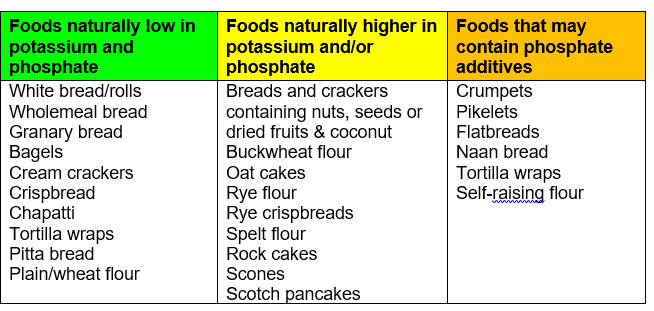
Breakfast cereals
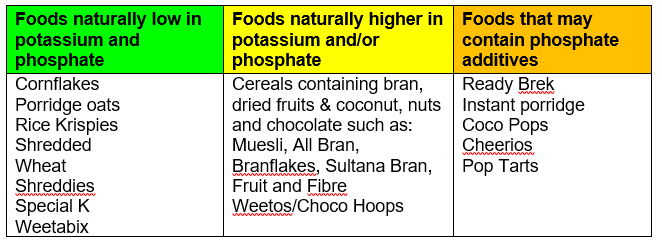
Potatoes
Most starchy foods are low in potassium and can be eaten freely. However potatoes are particularly high in potassium and should be limited.
150 grams (5 ounces)/3 egg sized potatoes may be eaten once a day. These may be swapped for 150 grams boiled sweet potato or yam.
Cooking methods to reduce the potassium
- The way you cook your potatoes and vegetables affects the potassium content. When they are boiled, some of the potassium is lost into the cooking water. This reduces the potassium content of the food. When little or no water is used, most of the potassium stays in the food.
- Boil potatoes and vegetables in plenty of water and make sure they are well cooked. Throw away this water and do not use it to make soups, casseroles or gravy.
- Peel potatoes before boiling when possible.
- Avoid using a steamer, microwave or pressure cooker for cooking potatoes and vegetables. You can use a microwave to reheat previously cooked vegetables or potatoes.
- Par-boil potatoes and vegetables for 5-10 minutes, before chipping or roasting or adding to stew, casserole or curries.
- Pasta and rice are much lower in potassium than potatoes. For rice or pasta dishes, you can use half large tin (200 grams) of canned tomatoes instead of potato.
If using quinoa, one portion (40 grams dry weight) can be used instead of potato at a main meal.
Rice, Potatoes, Pasta and Grains
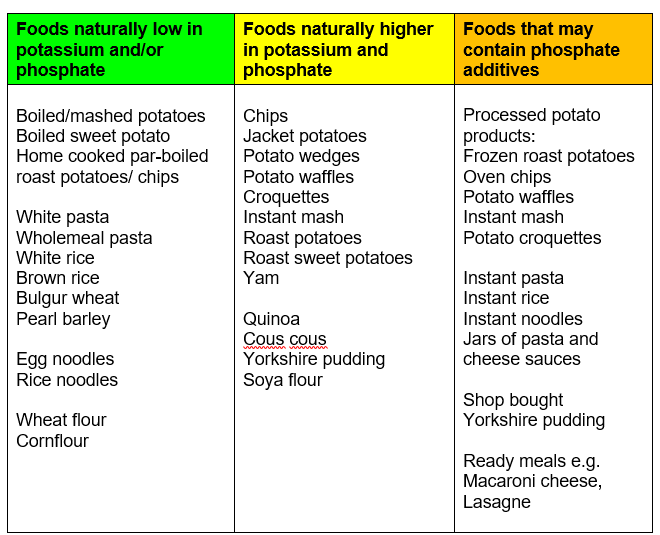
Meat, Fish and Eggs
These foods are good sources of protein, which is important for building and maintaining muscle and for fighting infection. Ensure you have these foods at two meals each day to ensure you have enough protein in your diet.
Use the following table to make suitable choices. Check that your serving sizes are similar to those shown below.

Average Serving Sizes:
Light meal:
- 1 to 2 slices cold meat: 30 to 60 grams (1 to 2 ounces)
- tinned tuna/salmon/mackerel 30 to 60 grams (1 to 2 ounces)
- 1 to 2 eggs
Main meal: 90 to 120 grams (3 to 4 ounces) cooked weight (about the size of the palm of your hand)
- 3 slices roast meat/1 average sized chop
- 1 chicken breast
- 1 fillet of fish
- 2 to 3 eggs
Tips:
- Meat and fish are excellent sources of protein, vitamins and minerals and have less phosphate than most dairy foods.
- Eggs are also a good source of protein and an alternative to meat and fish.
- Where possible, choose fresh meat, poultry and fish rather than processed foods, and prepare foods at home. This will help you to reduce your intake of phosphate. For example, processed meat can contain nearly 70% more phosphate than the fresh meat alternative.
- Cook large quantities of meals made from fresh ingredients to give you a tasty additive free meal, then freeze the leftovers.
- If using processed meat or fish at a main meal, serve with freshly prepared potatoes, rice or pasta, and vegetables.
- Try not to have fast food/takeaways too often.
Nuts, Beans, Lentils, Seeds & Meat alternatives
These foods contain both protein and fibre. The phosphate is mainly found as phytate and so less phosphate and potassium may be absorbed.
Note: Cooking can break down some of the phytate.
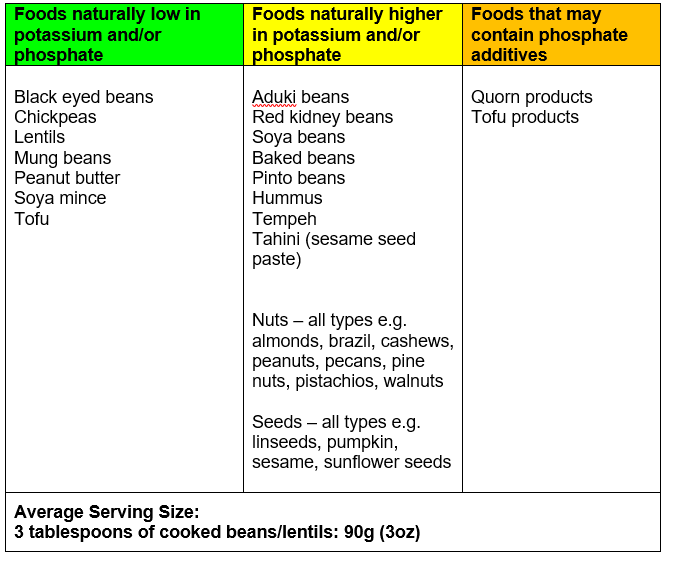
Note:
- All dried beans must be cooked thoroughly before eating.
- 30 grams of unsalted nuts (any type) per day is allowed.
- Up to 1 teaspoon of seeds may be eaten per day e.g. seeded bread.
Fruit and Vegetables
Fruit and vegetables are an important source of vitamins, minerals and fibre and help your bowels to open regularly.
Most fruit and vegetables are naturally low in phosphate, but be aware that some ready prepared fruit may contain phosphate additives.
All fruit and vegetables contain some potassium though the amount varies. Try to have a variety of fruit and vegetables daily. Adults are recommended to have five (80 grams) portions per day.
- An 80 gram (3 ounce) portion of fruit would be about a handful of small fruit (strawberries, raspberries, grapes etc) or a small apple, peach or tangerine.
- An 80 gram (3 ounce) portion of vegetables is about 3 heaped tablespoons or a small bowl of salad.
- 80 gram (3 ounce) portions are quite small. For example, a large handful of grapes (approx 20 grapes) may weigh about 160 grams (6 ounces) so this should be counted as 2 portions.
Fruit to avoid:
- Starfruit – this may cause dangerous side effects for those with kidney problems; it is therefore recommended that you avoid this.
- Grapefruit – you may be advised not to have this if you are taking certain medications.
You can choose 5 portions a day from the following lists, remembering that each 80g (3oz) portion is quite small (about a handful)
For your fruit and vegetables, choose mainly from the low and medium lists. However, you may have one serving of fruit or vegetable taken from the high potassium list per day.
Those fruit and vegetables that are very high in potassium should be avoided or used in very small quantities. Speak to the dietitian for further details.
Vegetables
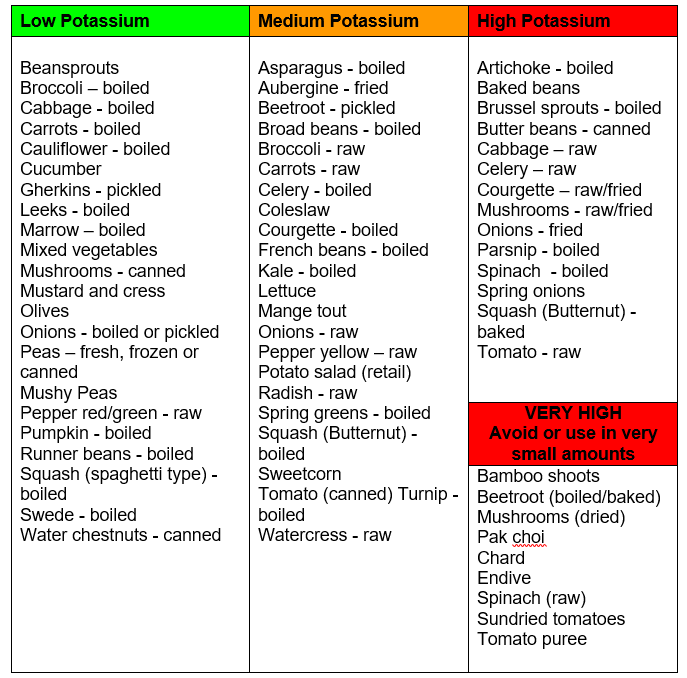
Tip
If your potassium level is well controlled, you may steam your vegetables as this helps to retain the vitamins. The potassium content will be slightly higher than boiled vegetables.
It is still important to boil potatoes as they contain a lot more potassium than most vegetables. Speak to your dietitian if unsure about how it is best for you to cook your potatoes and vegetables.
Fruit
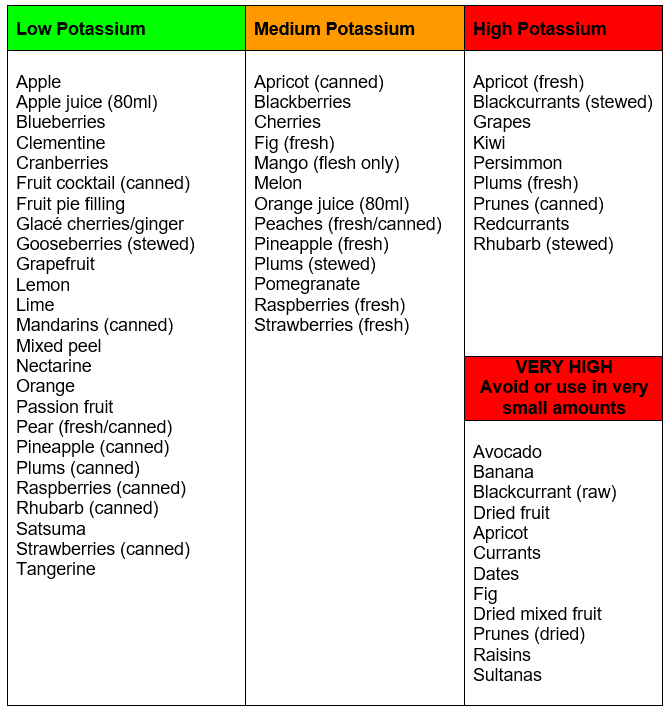
Dairy Products & Alternatives
Dairy foods such as milk, cheese and yoghurt are important sources of protein, vitamins and minerals. However, some of these foods are higher in potassium and phosphate than other high protein foods such as meat and fish, so it is important not to have too much. Some dairy foods are naturally lower in phosphate and are good choices.
In order to have enough protein but not too much potassium and phosphate, choose from the list below:
Dairy allowance
Milk e.g. pasturised cow’s milk (full cream, semi-skimmed, skimmed) – up to 300 millilitres (half pint) per day.
Hard cheese e.g. Cheddar, Edam, Wendsleydale, Red Leicester – Up to 120 grams (4 ounces) per week.
Dairy Products & Alternatives
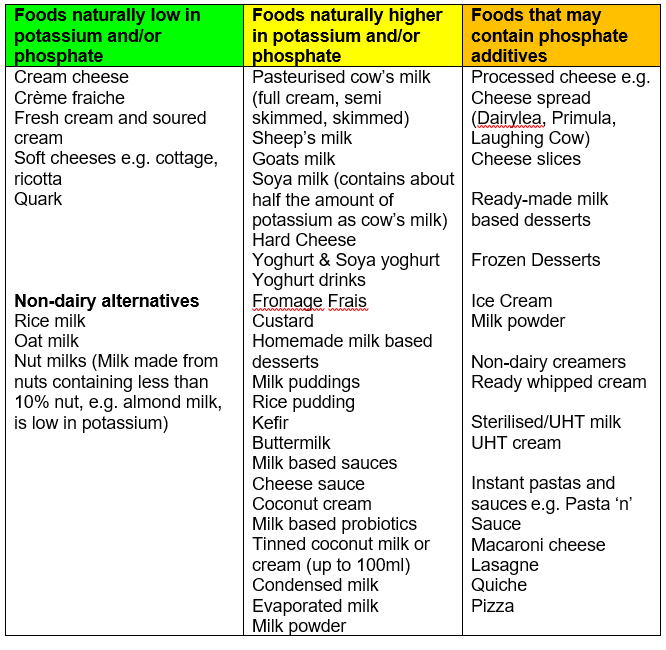
Tips:
- Rice, oat and almond milk are good substitutes for cow’s milk as they are lower in potassium and phosphate.
- Try making your own sauces rather than using a sauce mix.
- When using hard cheese, grate cheese to make it go further. Use mature cheese, as a small amount still adds plenty of flavour, or use some parmesan cheese in cooked dishes. Note: 30 grams (1 ounce) cheese is the size of a small matchbox.
Foods High in Fat and/or Sugar
These foods are high in calories and some are high in phosphate. Many baked goods contain some phosphate; the main sources being baking powder or self-raising flour, as well as some from dairy foods.
Processed foods such as cake mixes often have a higher phosphate content than the equivalent home cooked variety.
Aim to use these foods sparingly, unless you have a poor appetite or have lost weight recently. Ask to speak to the dietitian for further advice on this.
Fats and Oils
Most fats/oils are low in phosphate. Those marked ♥ are better for your heart.
| Monounsaturated fats ♥ | Olive oil, rapeseed oil, olive oil based spreads |
| Polyunsaturated fats ♥ | Sunflower, soya, corn oils and margarines made from these oils |
| Saturated fats | Butter, cream, lard and visible fat on meat, coconut oil |
Savoury Snacks
Note: These are often high in salt.
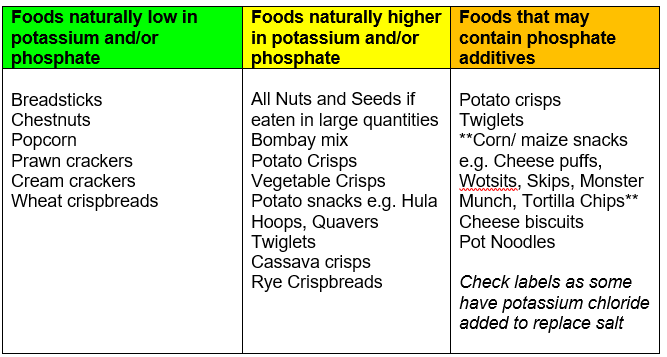
- Try to avoid eating too many savoury snacks as these can contain a lot of salt
Puddings
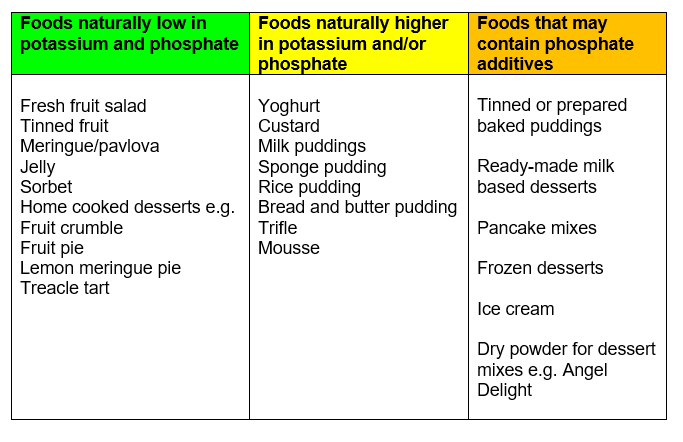
Tips
Extra snacks between meals and puddings may be useful for those with a poor appetite who are only managing small meals.
Puddings are often served with custard or ice cream. Cream or crème fraiche are lower phosphate alternatives.
When making cakes at home, try and avoid the use of baking powder and keep the use of self-raising flour to a minimum.
Sugar and confectionary
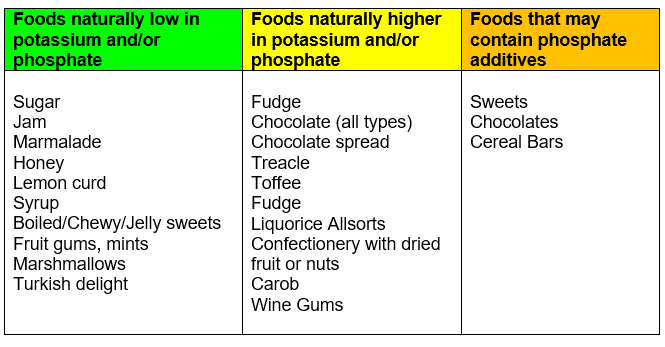
Biscuits and cakes
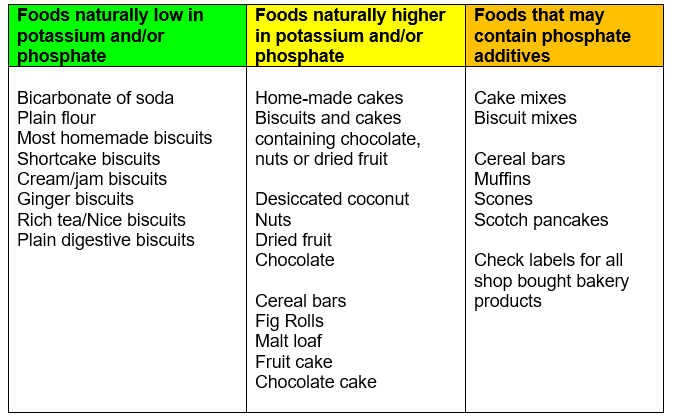
Drinks
Most drinks are fairly low in phosphate. However there are some drinks that are much higher. Most dark fizzy drinks contain phosphate additives. Keep these to a minimum and choose light coloured fizzy drinks instead.
If you need to watch your fluid intake, ensure that you count all these drinks as part of your daily fluid allowance.
Speak to your dietitian if you are taking supplement drinks such as Complan or Meritene.
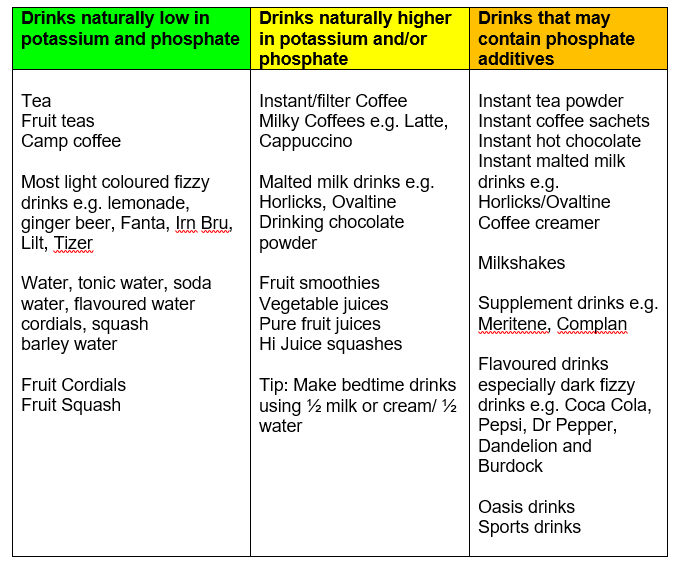
Alcohol
Beers, lagers and wines often contain phosphate released from grains and seeds during the process of fermentation. These drinks are also higher in potassium. To drink within sensible limits, men should not drink more than 3 to 4 units of alcohol per day and women no more than 2 to 3 units of alcohol per day. Try to have some alcohol free days.

Miscellaneous
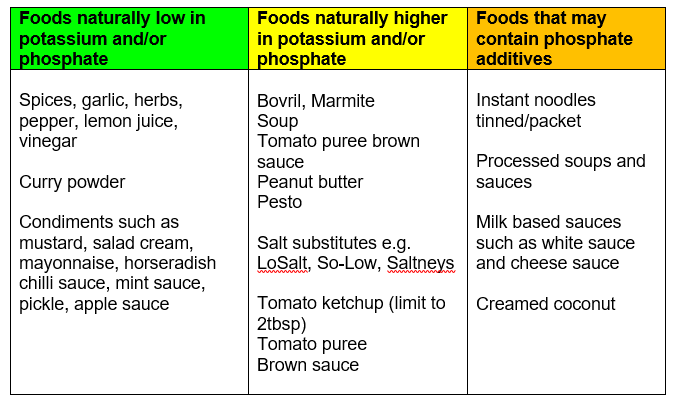
- Commercial foods may be high in salt or potassium chloride.
- Try to make your own sauces and soups rather than using pre-prepared jars, packets or tins
In summary
The dietary advice in this booklet has been developed by registered dietitians. Using this guide can help you to choose the foods that you enjoy whilst keeping your blood levels well controlled.
Renal dietitians in the UK have looked at the latest evidence regarding both potassium and phosphate.
We recommend the following for a healthy diet:
- Where possible, choose fresh rather than processed foods and prepare foods at home.
- Choose fresh meat, poultry, fish, eggs, beans and pulses together with a moderate intake of dairy foods to ensure an adequate protein intake.
- Use wholegrain foods where possible.
- Reduce your intake of foods and drinks high in potassium and phosphate that have low nutritional value.
- Where possible, choose commercial foods and drinks that have been prepared without phosphate additives or potassium chloride.
Further information is available from your dietitian, including recipes, so please ask.
Should you require further advice, please do not hesitate to contact the Dietetics Department on tel: 01482 674490

